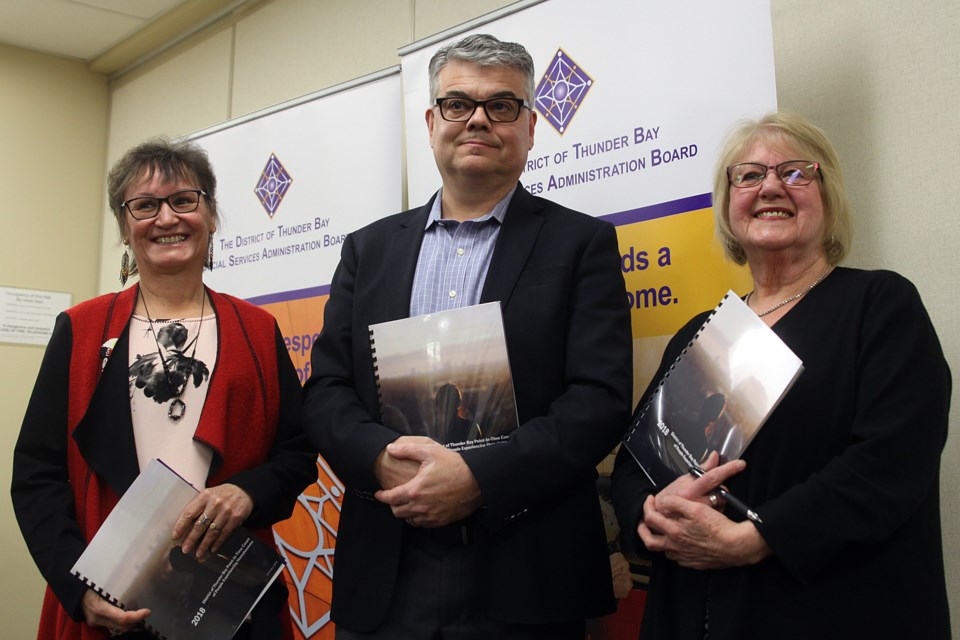THUNDER BAY – Social services organizations and agencies have a more complete picture of the extent and causes of homelessness in the city.
The full report from this year’s point in time count for those experiencing homelessness, the second to be conducted in Thunder Bay, was released on Tuesday. The report includes data identifying underlying causes, as well as six recommendations to address homelessness.
The 24-hour count, which was conducted in April, found there were 516 people living without permanent housing in the city, with 474 of those completing a survey to provide demographic data.
Thunder Bay District Social Services Administration Board chief administrative officer Bill Bradica said the report provides concrete evidence to the provincial and federal governments about the homelessness situation.
“This will help to really drive the point home that there is a serious issue in terms of homelessness in not only the city of Thunder Bay but the district of Thunder Bay and that needs to be addressed,” Bradica said.
“We’ve also identified through the data what some of the major underlying causes of homelessness are and the importance of addressing those underlying causes to help prevent more people in the future from becoming homeless.”
The first enumeration, which was done in 2016, found there were 289 people living homeless in Thunder Bay.
Lakehead Social Planning Council social researcher Bonnie Krysowaty said the increase found this year is likely a combination of more people living homeless as well as organizations and agencies reaching more people who did not participate in the initial 2016 count.
“I don’t think we’ve seen double the amount of homeless individuals in Thunder Bay. I don’t think that’s the case but I do think it points towards an epidemic,” Krysowaty said.
“The numbers are growing. They’re not decreasing. Part of that too is reaching out to organizations, reaching out to people.”
The majority of respondents – nearly 75 per cent – indicated they came to Thunder Bay from elsewhere. Fifty-five per cent had been in the city for more than a year, while 13 per cent had been in Thunder Bay for less than a year.
Bradica said those arriving from outside of Thunder Bay include people from northern communities, as well as a significant number from Winnipeg and others from cities like Toronto and Calgary.
One of the recommendations in the report is to conduct research to find out why those people came to Thunder Bay.
“What can then be determined is are there things that can be done in those other communities to keep people where they want to be,” Bradica said. “Depending on where they’re coming from, it’s looking to either the provincial or federal government to ensure there are appropriate supports in various communities, not just in the larger centres.”
Of the people to complete a survey, 66 per cent of respondents identified as Indigenous.
Thunder Bay Indigenous Friendship Centre executive director Charlene Baglien said culturally appropriate supports need to be included to address Indigenous homelessness, which was a recommendation included in the report.
“That is absolutely a must. Yes, Indigenous homelessness is not just about having a physical structure to live in,” Baglien said. “It’s about a holistic service delivery that addresses mentally, emotionally, spiritually and culturally speaking one’s being and their connection to the land.”
More than half of the respondents reported to be couch surfing, a precarious living situation where they have no permanent home.
“They’re people that are staying on friends’ couches, relatives’ couches. It could be anyone from a student who has nowhere to live because there is just no housing available to people that have split up from a relationship or there was violence or people have been evicted. Substance use issues have been a problem,” Krysowaty said.
“When we are developing programs and supports, it’s not a matter of just building another shelter or even offering the types of supports or services somebody from a shelter might need. It’s just being aware that there are so many different reasons for homelessness and different solutions.”
The report recommends the development of a coordinated access system to best utilize existing resources.
“Being able to coordinate all of the services, supports and resources that are available for people and then when somebody enters that kind of system it can be more easily decided upon which resources they should be pointed towards, which supports they should be offered and what type of housing situation would be most beneficial for that person,” Krysowaty said.
More than 70 per cent of participants reported having addiction issues that either caused or contributed to them becoming homeless.
Other recommendations include advocating for support for addictions treatment, addressing the service gaps in child welfare systems and individuals aging out of foster care.
Bradica said the social services board is looking at increasing private market rent supplements and using portable housing benefits with a goal of adding 30 to 40 units per year over the next five years to eventually increase housing inventory by 200 units. So far, 75 people have been housed through the board’s prioritization of its high needs homelessness wait list, which the report recommends expanding.
